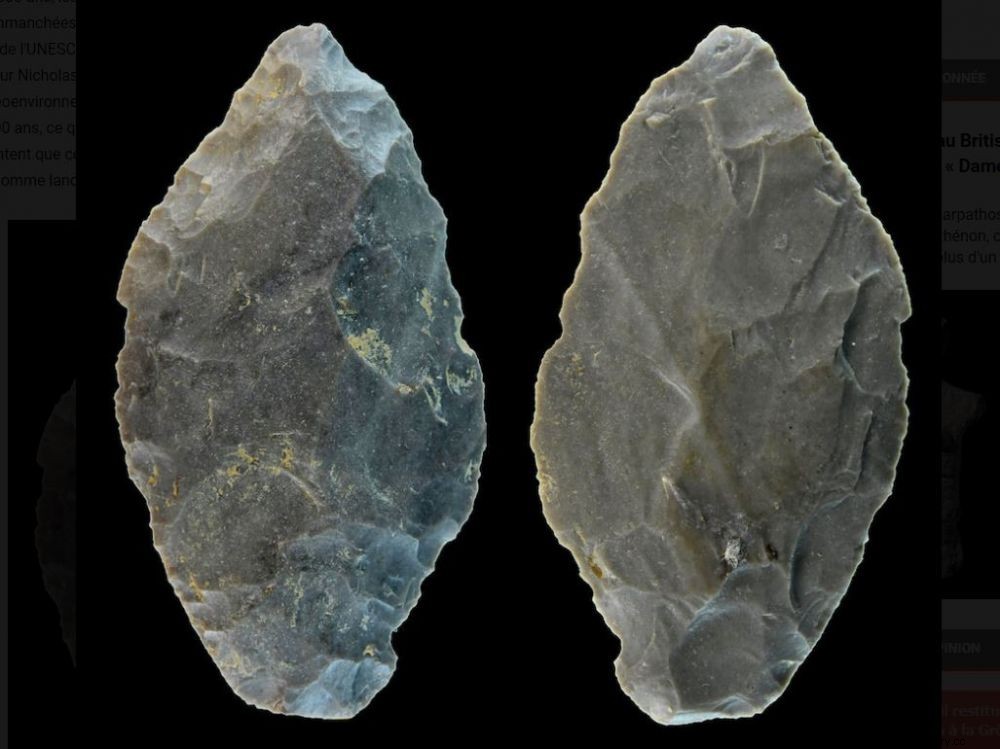A leaf-shaped point dated to at least 65,000 years old has been discovered in the famous Hohle Fels cave in southern Germany. Her study suggests that she was attached to a spear and used in great hunts.

Foliaceous point of the cave of Hohle Fels, in the Swabian Jura, in Germany.
Examination of the carved stone that he had fixed to the end of his spear with the help of vegetable resins, reinforced with leather ties and sinew, had led the Paleolithic hunter to make a decision:he was going having to sharpen his weapon if he wanted to continue hunting. Because it was not with this damaged projectile point that he was going to be able to pierce the chest of a reindeer or that of a wild horse! To sharpen it, he only had to return to the nearby shelter where his group was. In doing so, this Neanderthal hunter was far from imagining that 65,000 years later, the tool he had finally had to abandon in this cave would be found in the 21st century by men belonging to another species:Homo sapiens that his descendants would encounter a few thousand years later in this corner of Europe, but that he would never encounter.

Overview of the archaeological excavations carried out in the prehistoric site of Hohle Fels, in 2020. Credits:N.J Conard / University of Tübingen
The site of "the dug rock" has already yielded many remains
After 25 years of archaeological excavations at Hohle Fels, in the Ach valley, in southwestern Germany, the study of the prehistoric layers occupied by these populations continues to write this distant page of history. Classified on the UNESCO World Heritage List, the site of "the hollowed rock" (its name in Swabia), has already yielded many vestiges. In 2008, in the rich Aurignacian strata of the cavity, an extraordinary 35,000-year-old Venus carved in mammoth ivory was found there. A discovery made by Nicholas Conard, from the Department of Ancient Prehistory and Quaternary Ecology at the University of Tübingen (Germany), whose team has just brought to light again, 1.20 meters below the levels of the treasure ivory, a 65,000-year-old quartz point. A find published in two specialist journals Archäologische Ausgrabungen in Baden-Württemberg and Mitteilungen der Gesellschaft für Urgeschichte .

Leafy tip of Hohle Fels. Credits:A. Janus / H. Würschem
A tool with countless signs of wear
To hunt, a skilled technician, Neanderthals knew how to shape very beautiful tools. And in the Middle Palaeolithic, fitted to a wooden spear, the bifacial foliate point (with the appearance of a leaf) unearthed at Hohle Fels had been used to kill big game. "But in the Swabian Jura, this is the first time that such a point has been encountered in situ in a modern excavation. The previous one was in 1936 , declares the prehistorian joined by Sciences et Avenir . Most importantly, this type of cutting-edge was previously thought to be part of the transition industries [between Neanderthal and Sapiens editor's note] and had only been used by Neanderthals between 45,000 and 55,000 years ago , during the last phase of their presence in Central Europe! But it is not so". What to revise the knowledge on Neanderthal productions of the Middle Paleolithic (300,000-45,000).
Even more surprisingly, by carrying out micrographic analyzes on this leafy biface using powerful stereoscopic microscopes, Dr. Veerle Rots, director of Traceolab, at the University of Liège (Belgium), -a state-of-the-art laboratory on manufacture, use, and understanding of the life cycles of prehistoric tools-, was able to identify the countless traces of wear due to its use, but also, to note that in an attempt to resharpen, the end of the tool had been broken. Chipped, no longer suitable for hunting, the projectile point had been discarded. A Neanderthal hunting scene that archaeologists were able to resuscitate 65,000 years later, each time documenting the evolution of this activity better.
